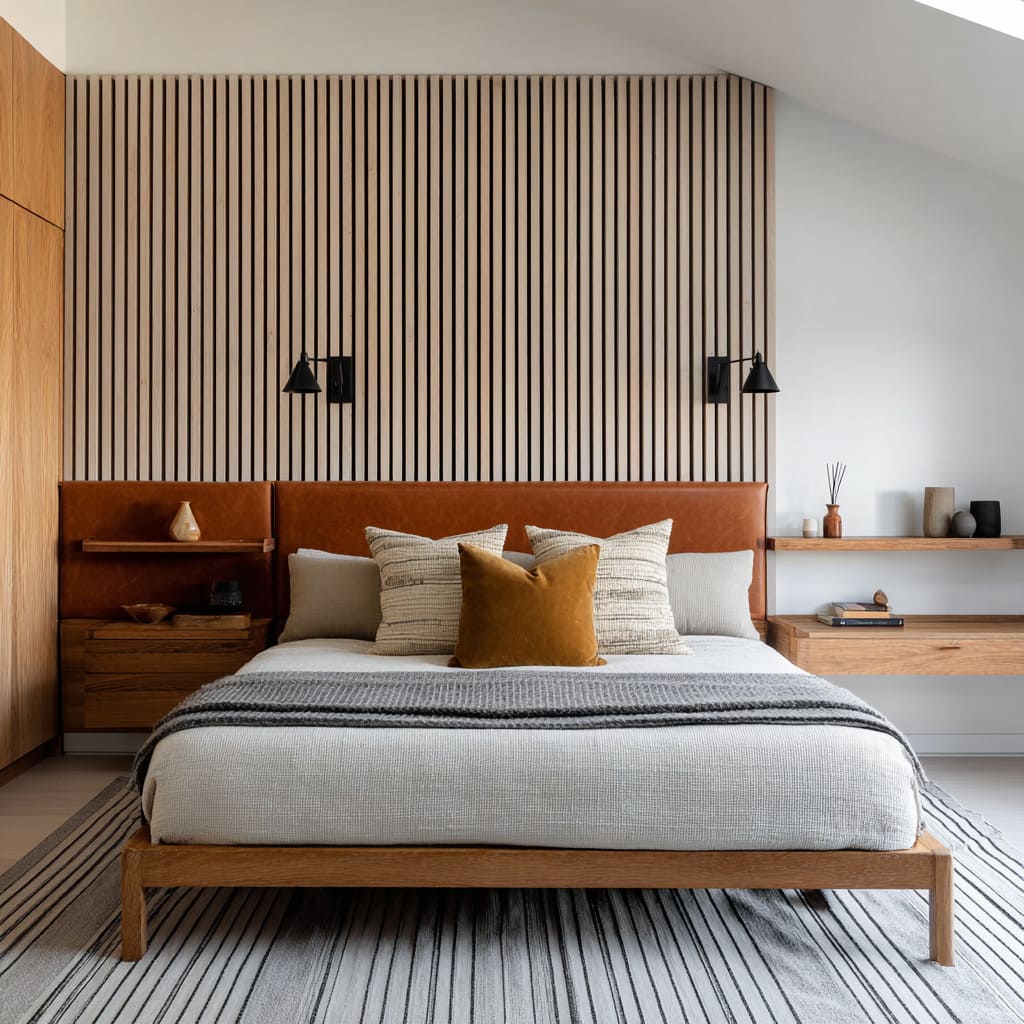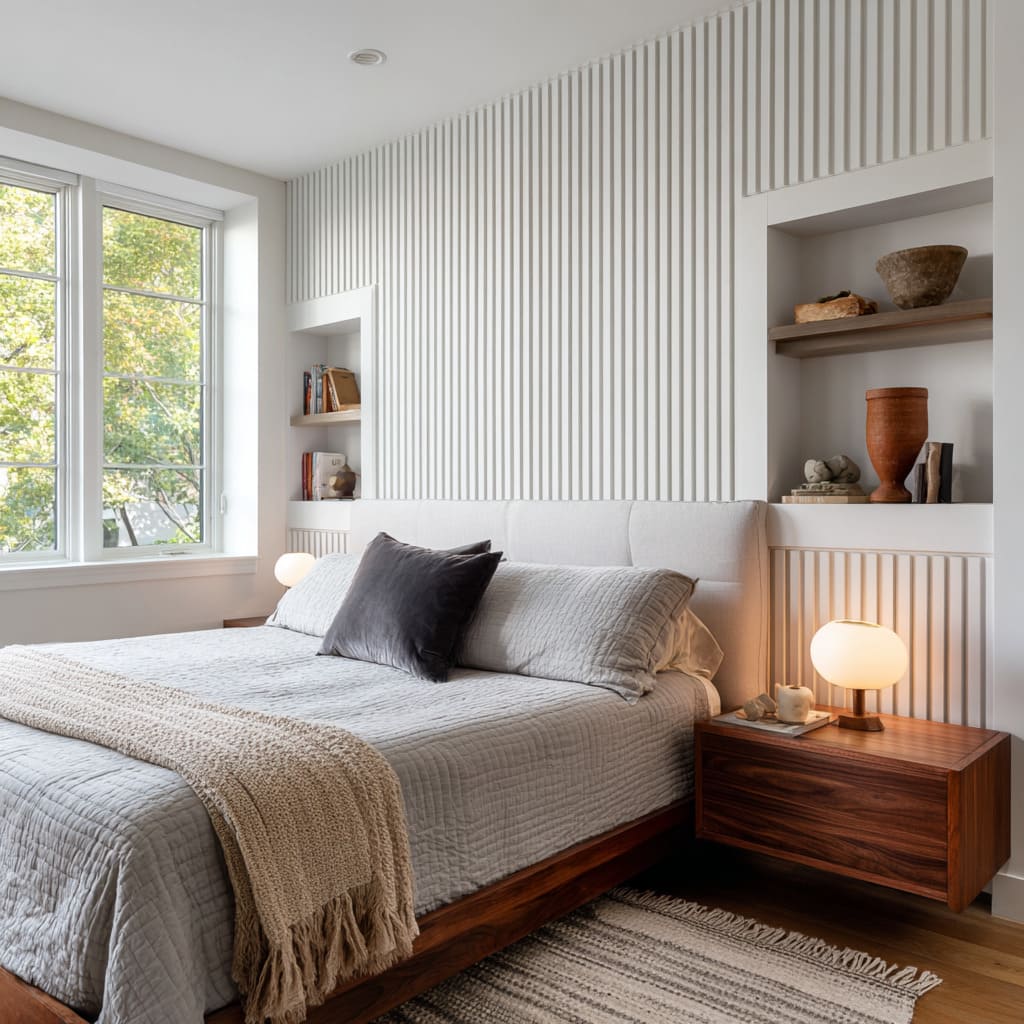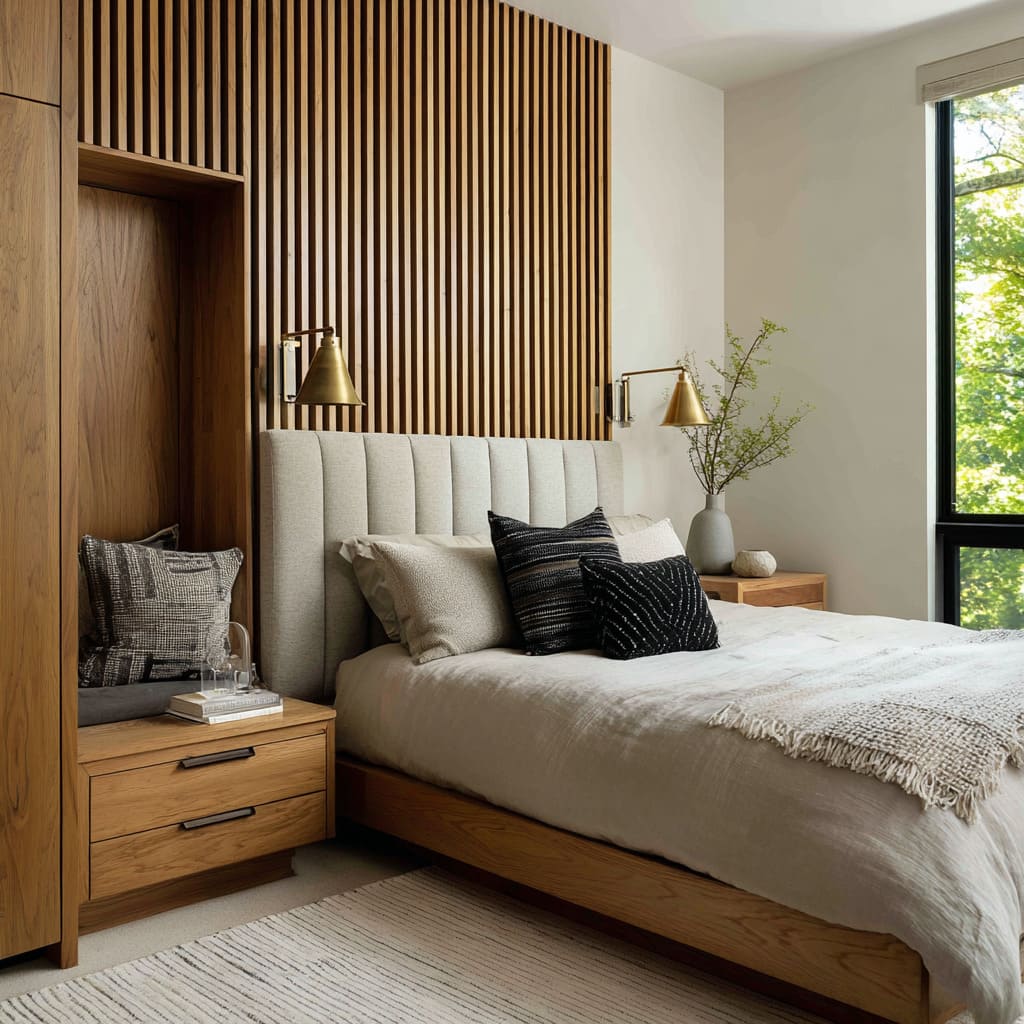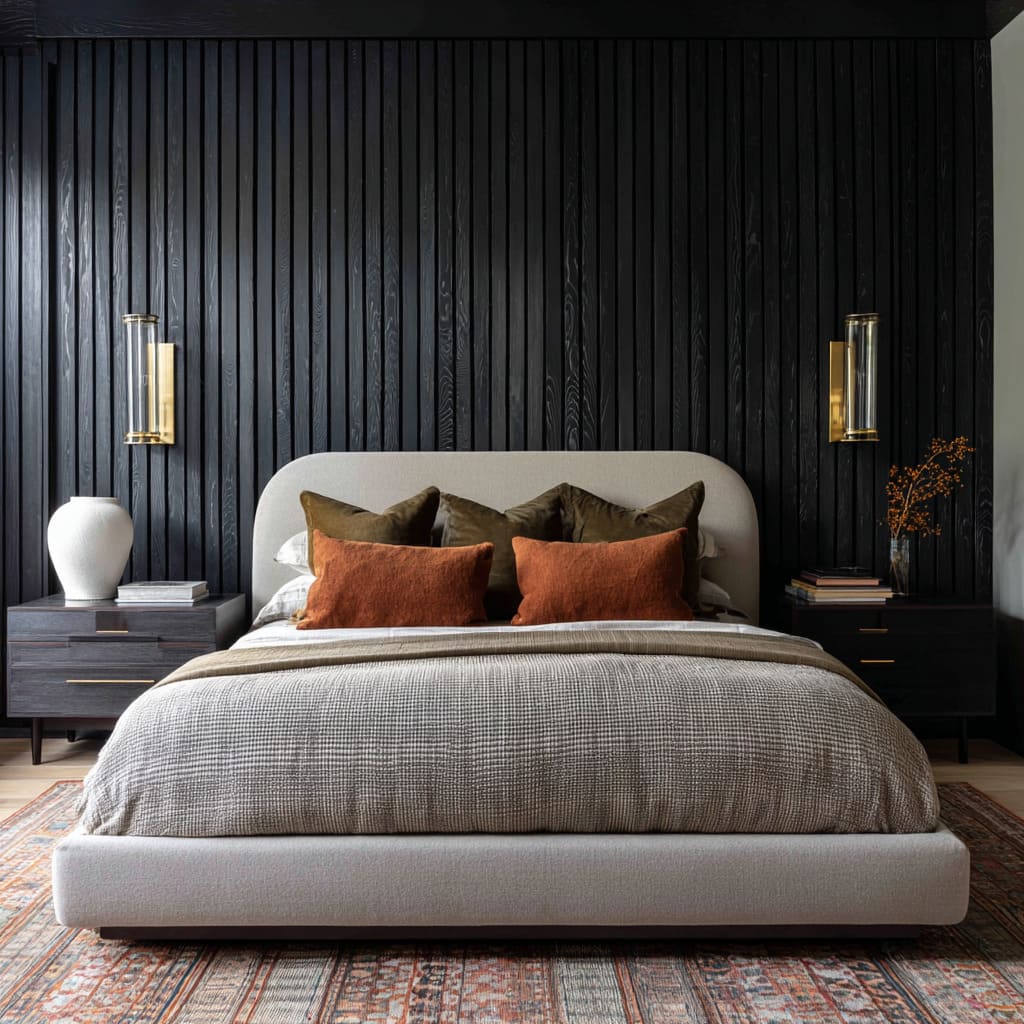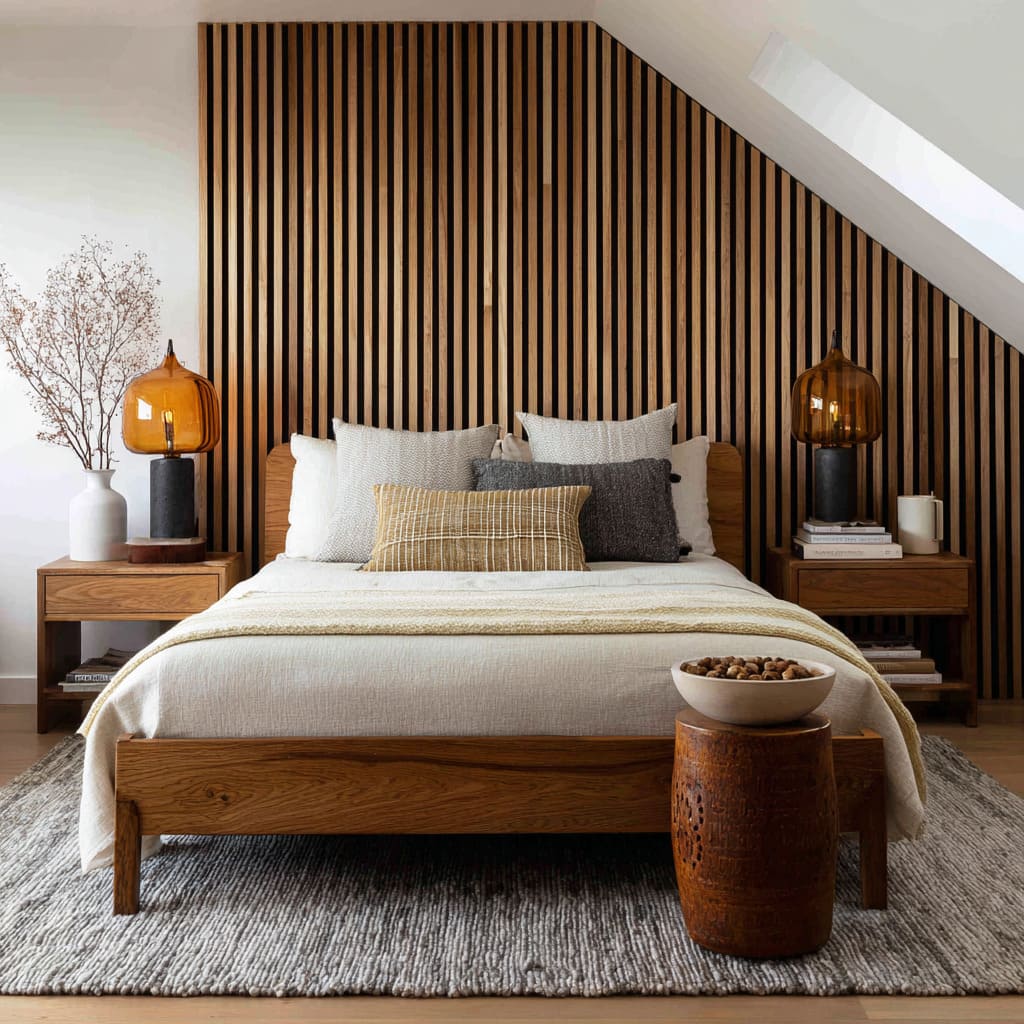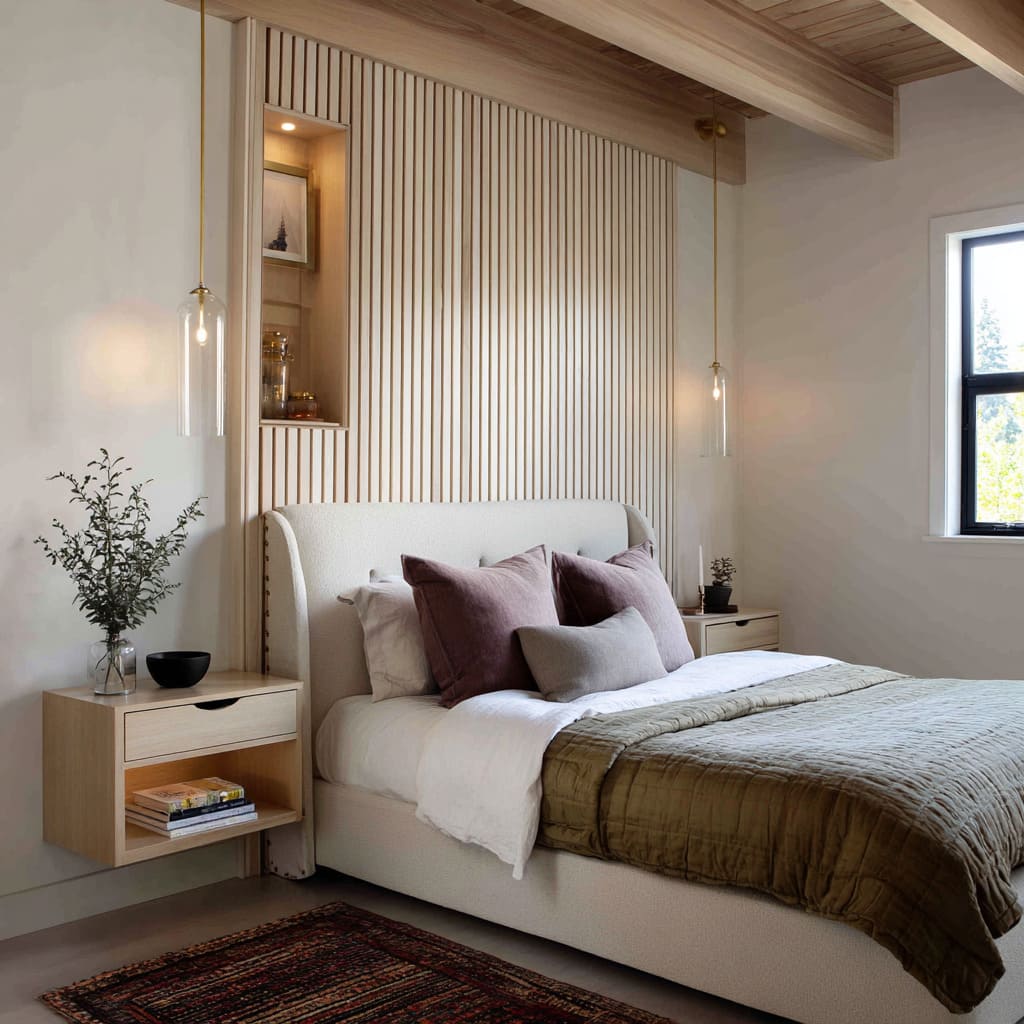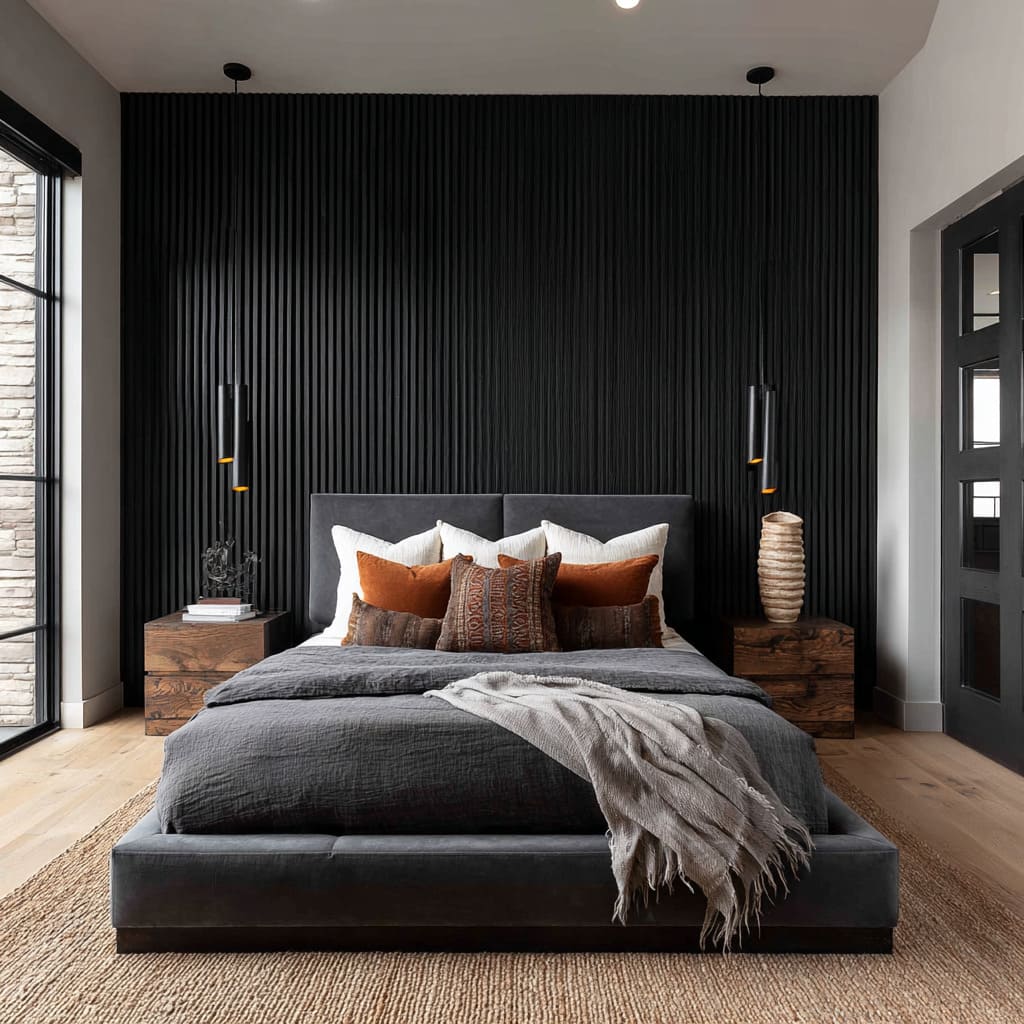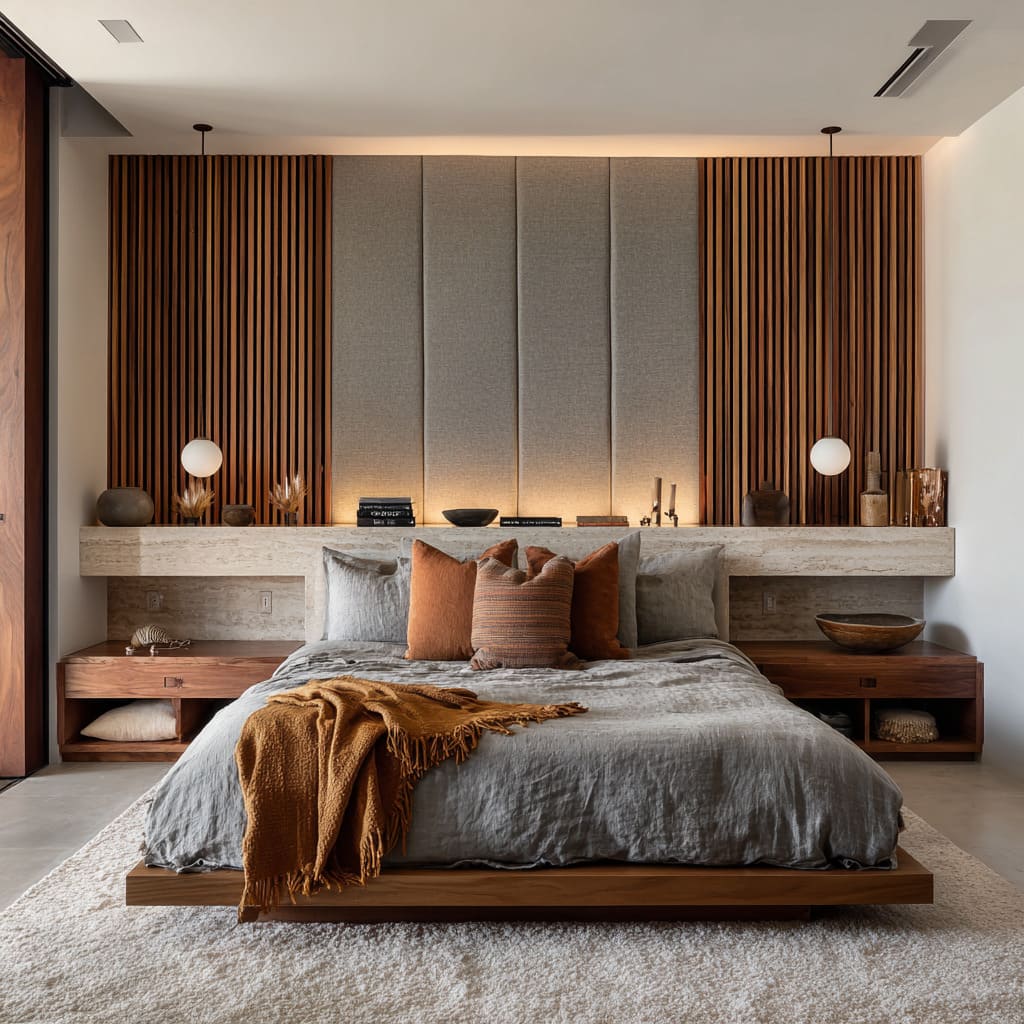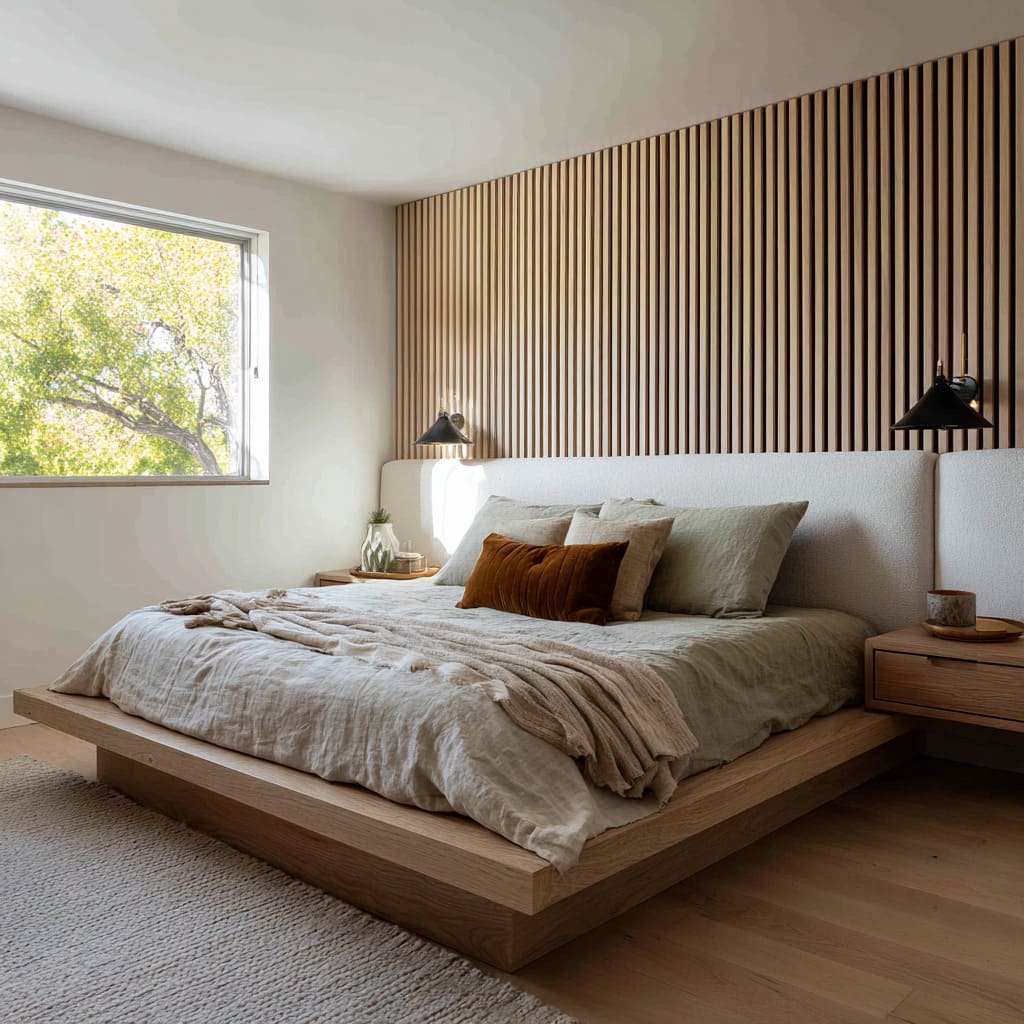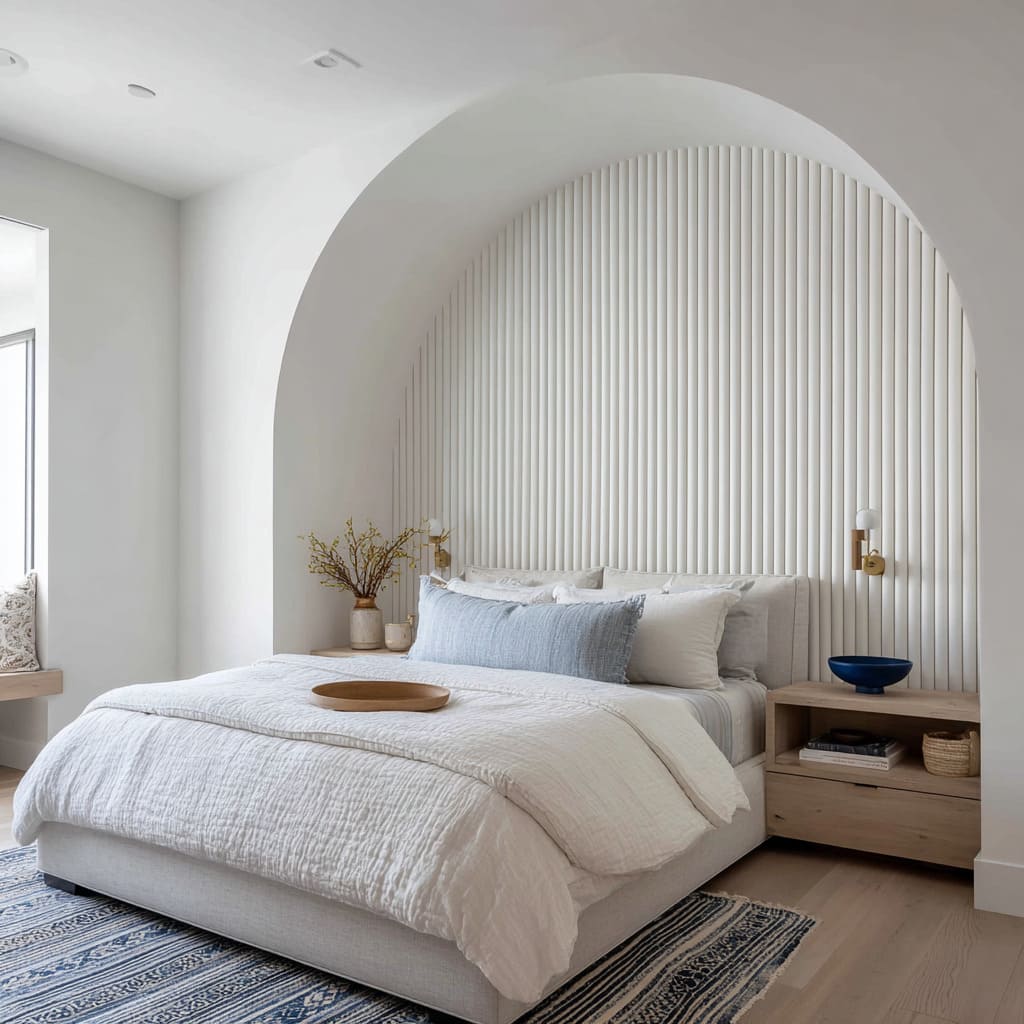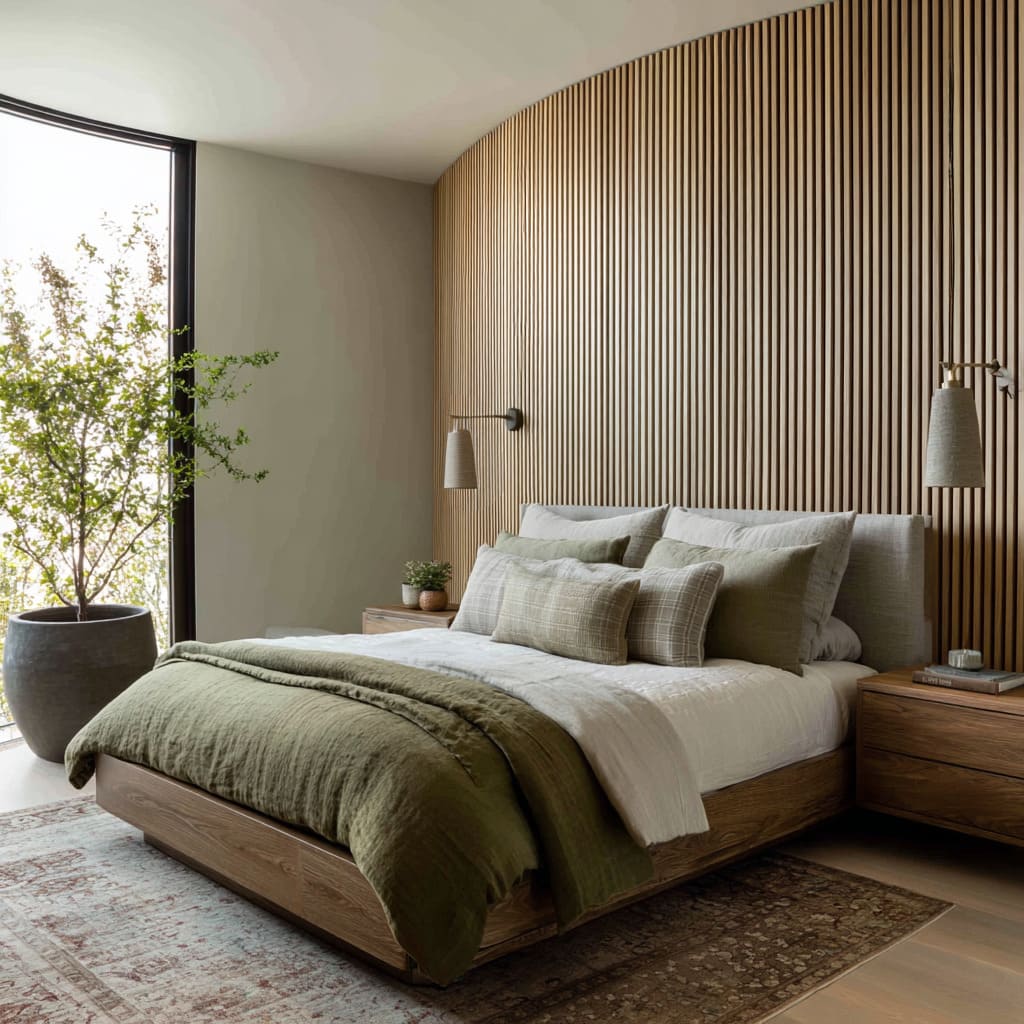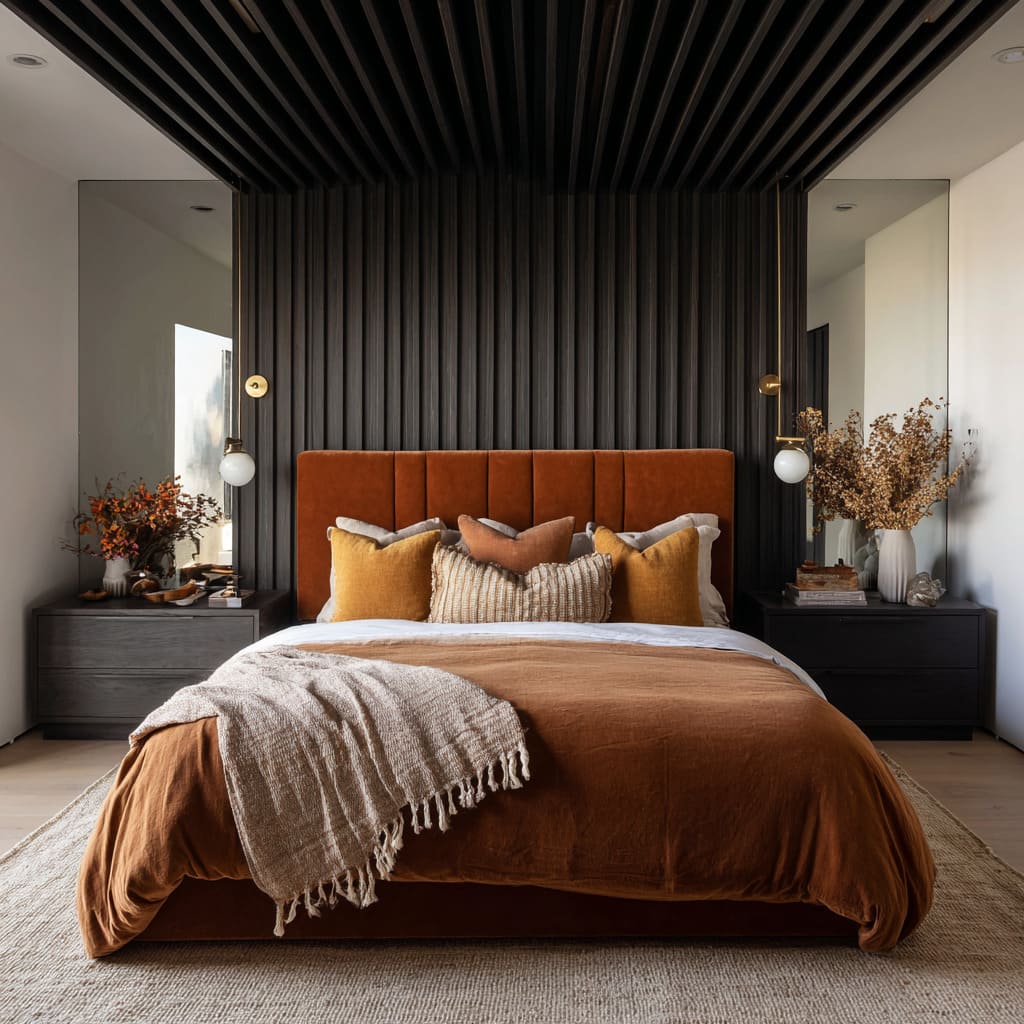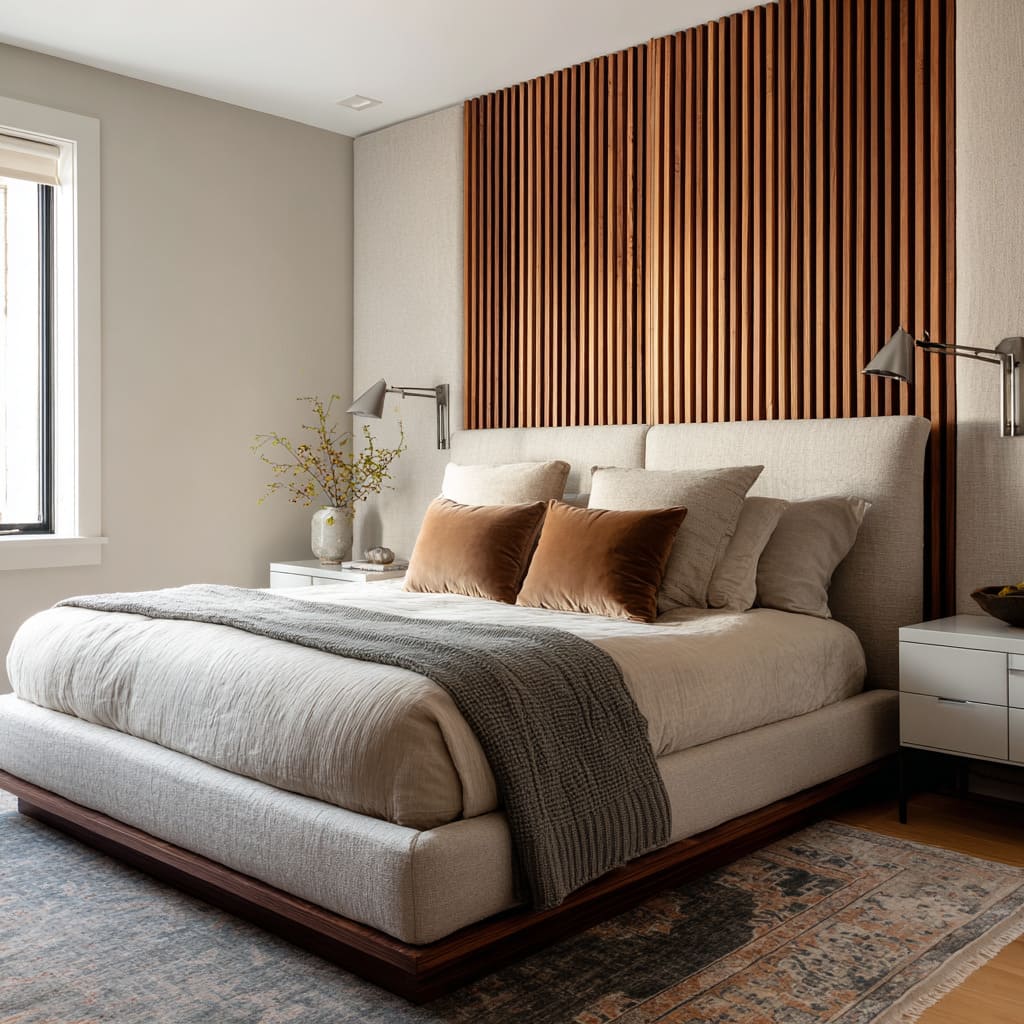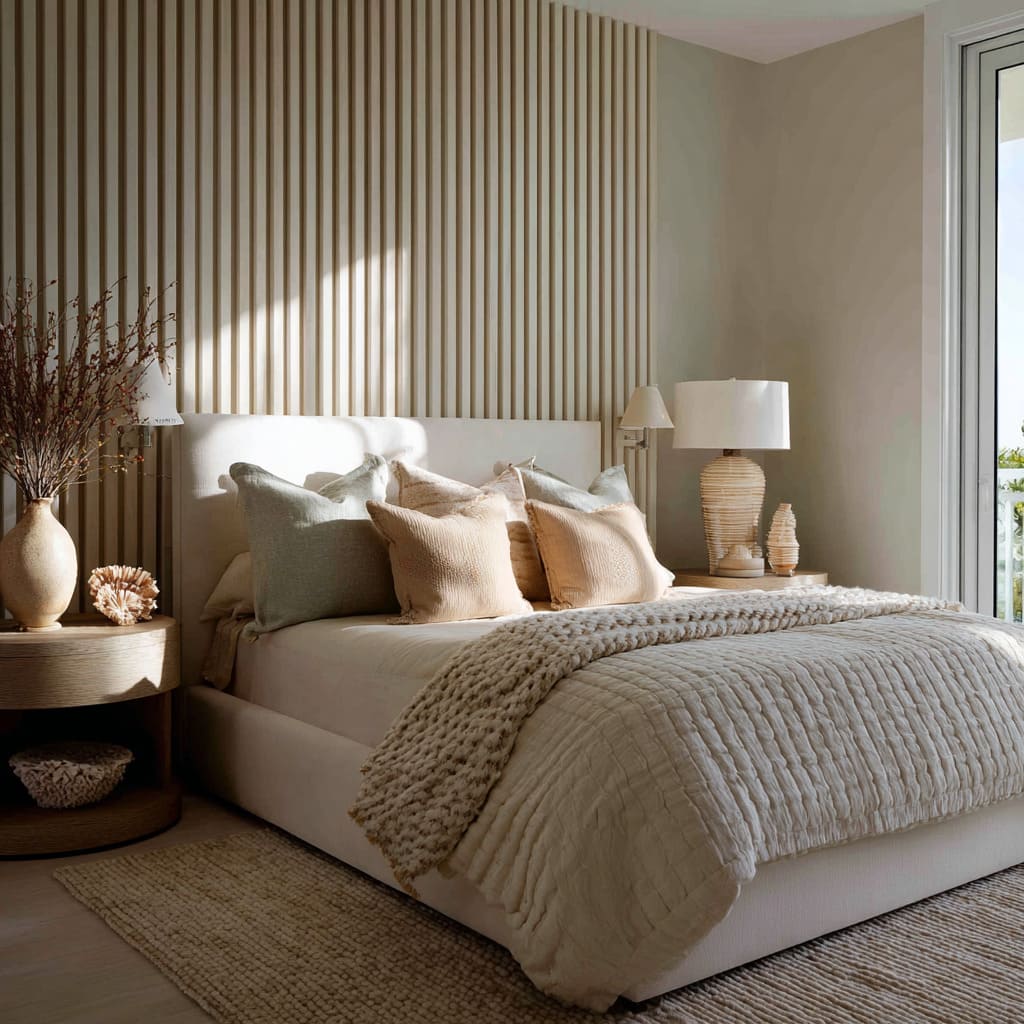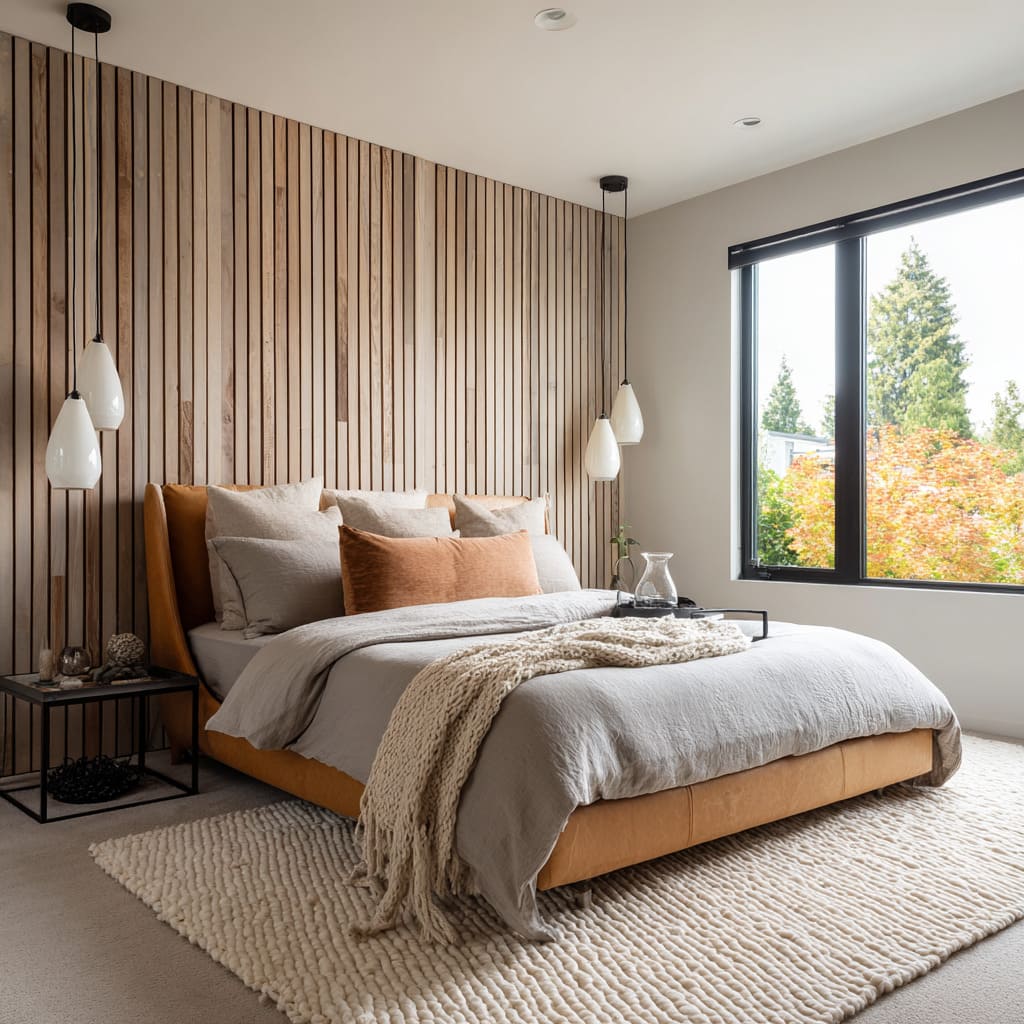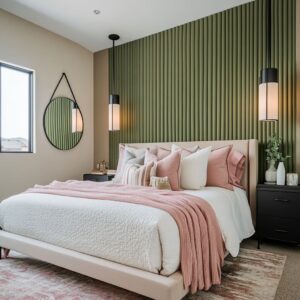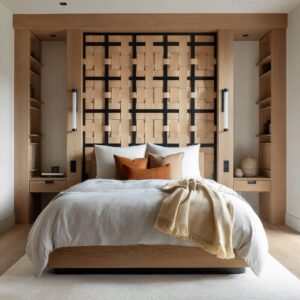Timber slats have shifted far beyond their earlier decorative roles. In today’s interiors, they are used to frame, divide, and define space—not just cover it.
Vertical repetition adds rhythm, but it’s how that rhythm is handled—broken, curved, framed, shadowed—that creates presence.
Current slat wall bedroom ideas explore more than layout—they test the boundary between architecture and decoration. From ceiling-wrapped volumes to partial panels that float within framed edges, the focus is on structure, light, and proportion.
The direction is less about dramatic finishes and more about quiet control: clean transitions, texture layering, restrained tones, and occasional interruptions that serve a visual purpose.
This article looks closely at the visual logic behind these surfaces—how minor shifts in alignment, lighting, material, or shape can steer the entire room. It’s not about adding more, but about using the wall itself as a structured part of the composition.
Breaking the Uniform: Small Shifts That Reshape Perception
In many bedroom slat wall compositions, subtle design choices create the visual break that elevates the entire surface. A field of vertical strips—identical in size, spacing, and tone—can easily drift into background noise.
But introducing a pattern of mixed widths, or positioning the wall slightly off-center from windows or furniture lines, injects a layer of complexity without visual noise.
Some layouts adjust spacing just enough to make the texture feel rhythmically alive, while others use deliberate asymmetry to build movement. These quiet alterations prevent the wall from reading as a flat installation and instead allow it to feel crafted and grounded in its setting, as if it grew naturally from the space rather than being fixed onto it.
Within these types of slat wall bedroom ideas, the most compelling results often come from shifts that aren’t immediately obvious, but shape the way the room feels over time.
Shadow as Texture: How Light Becomes Part of the Surface
Certain designs turn the interaction of light and wood into a layered effect, building richness without changing a single material. A line of LED light tucked into the ceiling edge can cast a warm gradient over slats, making each rib feel deeper and more dimensional.
When sunlight enters from the side and cuts across grooves, the result is a moving sequence of light bands—a surface that subtly shifts across the day. In curved installations or ceiling-mounted extensions, this flow becomes even more dynamic.
Instead of applying another finish or stain, such spaces rely on shadow play as their finish, allowing contrast and depth to form purely through placement and rhythm. This approach doesn’t compete with the materials—it refines them, making the bedroom slat wall a participant in the room’s atmosphere rather than just a backdrop.
Curved Layouts That Break the Grid
Straight lines can bring order, but they can also harden a room’s mood. That’s why curved slat wall layouts stand out—they reshape the sense of space with a simple arc.
Instead of continuing the upright rhythm in a strict line, a slat wall that bends gently around the headboard softens the layout without losing structure. These arcs wrap the bed like a shallow enclosure, offering a more enclosed visual feel while still allowing openness.
The play of light across the curvature produces fan-shaped shadows that shift as daylight changes, letting the surface breathe. This motion keeps the vertical flow from becoming repetitive.
In some layouts, the ceiling even echoes the same bend, making the whole structure feel unified. Within a wood slat accent wall bedroom, introducing a curve can do more than soften—it reshapes the composition into something spatial, not just decorative.
Contrast Built on Texture, Not Just Tone
Visual contrast goes beyond light and dark. In bedroom designs that feature wooden slats behind bed setups, the most compelling pairings often come from opposite materials—not opposite shades.
A wall of rough, matte black timber feels sharper when paired with a velvet headboard in deep rust or clay. Similarly, pale oak gains dimension when set next to softly structured grey fabric.
The visual contrast is heightened by how surfaces react to light: one absorbs it flatly, the other diffuses it through folds and plush depth. These combinations make the wall feel like part of a tactile structure, not just a decorative surface.
Instead of pushing the timber to the background, the mix of hard and soft makes each surface pull the other forward. This kind of material tension gives the room depth, balance, and a sense of considered layering—all without overcomplicating the palette.
Vertical Continuity That Climbs Overhead
Some slat wall bedroom ideas take the concept further by letting the slats rise beyond the wall and continue over the bed, forming a visual lid that reshapes the volume of the room. This ceiling integration creates a structured envelope, outlining the sleeping area as its own zone without needing walls or partitions.
The effect feels like a canopy, but cleaner—defined purely by texture and rhythm.
Even with the overhead surface enclosed, the ends often remain open, keeping air and light moving freely. The result is a contained yet breathable space, where the eye reads continuity rather than interruption.
This use of overhead slats also changes how light behaves; indirect lighting placed at the upper edges casts a soft downward glow that adds warmth without flattening the texture. By expanding the slat wall behind bed to the ceiling, the room becomes a single coordinated surface, shaped around stillness and material rhythm.
Empty Edges as Intentional Framing
Where some bedrooms extend slats from edge to edge, others intentionally stop short, carving out visual margins that highlight the central field. These gaps—above, beside, or even below the wall—act like quiet pauses between materials.
Framing the slats within a border of plain surface pulls the texture forward, the same way white space enhances the presence of an image. This use of negative space isn’t blank—it’s active, helping the eye rest and return.
Whether the wall is framed with matching wood, light trim, or left open to the paint color behind, the absence around the pattern creates a feeling of balance. In many cases, these framed compositions read more like architectural inserts than applied decoration, giving a sense of precision even in rooms with softer elements.
The restraint adds sharpness without adding bulk, proving that less wall can sometimes produce more presence.
Purposeful Interruptions That Reinforce the Pattern
Some of the most refined slat wall ideas use insertions with restraint—not to break the rhythm, but to anchor it. Small ledges made of stone, a brushed brass strip, or an inset shelf can land exactly where the eye expects repetition, then pause it with intention.
These additions don’t scream for attention; they sit inside the cadence of the grooves, aligning with the vertical spacing and following the same grid logic. A floating display shelf carved directly into the timber, for example, draws the eye without disturbing flow—because its scale and position feel measured, not random.
The key is that each addition serves a clear visual or functional role: it might hold sculpture, bounce light, or draw a horizontal line that balances the vertical weight. None of these elements are treated like decoration—they act more like punctuation, giving the slatted surface rhythm and pause without adding clutter.
Restrained Color That Lets Grain Do the Work
While texture carries much of the visual load in slatted compositions, color decisions play a quiet but essential role. Most bedrooms with strong timber elements lean into compressed color palettes—often two or three tones that share a warm or cool base.
This kind of discipline avoids overpowering the wood’s surface, allowing the natural variation in grain, spacing, and shadow to remain the focus.
A common example might be deep charred wood next to off-white boucle and taupe throws, or pale oak surrounded by soft greens and faded terracotta. Occasionally, a sharper accent is introduced—a single mustard or rust cushion, a dark glass lamp base, or a matte black pendant—but always as a pinpoint, never as a dominant tone.
The result is a space where visual warmth comes from material itself, not from strong chromatic contrast. This kind of palette invites slow looking—it gives time for details like light absorption, finish texture, and edge transitions to stand out naturally.
Balanced Layouts That Know Where to Break the Mirror
Symmetry in interiors can feel grounding—but in textured environments like a slatted wall bedroom, perfect balance isn’t always the answer. Matching nightstands, twin pendants, and centered artwork can calm the eye, especially when the slats themselves bring in a lot of vertical motion.
Yet, too much mirroring can flatten the effect. That’s where selective disruption becomes powerful.
A slightly lower pendant on one side, or a shelf that slides away from center, can bring relief without making the space feel off. The real finesse comes from reading the weight of the wall—if the slats are narrow and dense, keeping accessories in line helps.
But if the timber is wide or broken up with inserts, a small shift might do more to create flow than forced symmetry ever could. It’s about balance, not repetition.
Designs That Respond to Structure, Not Just Style
The strongest examples of modern wall treatments come from surfaces that react to the shape of the room itself. Slats that rise along a pitched ceiling line, or that wrap perfectly into a custom alcove, feel like they belong there.
Instead of imposing a visual system over the space, these treatments follow the architecture’s lead, matching proportions, shadow lines, and natural breaks. The result is quieter but more lasting—it makes the wall feel grown into the room, not applied to it.
In many rooms, this approach even corrects visual awkwardness. A tricky corner, a slope, or an offset can become a feature once the slats acknowledge it.
These compositions don’t shout—they just fit so precisely, the viewer stops seeing lines and starts sensing shape. And in those cases, slatted wall bedroom designs stop being background and start becoming spatial frameworks.
Soft Layers That Echo Structure Without Noise
In rooms built around vertical slats, introducing too many bold accents can create visual tension. Instead, designers often layer textures that echo the wall’s rhythm in quieter forms.
A boucle headboard repeats the softness in raised loops, while a thick jute rug grounds the space with coarse fiber lines. Ribbed ceramics on the nightstand or a heavy knit throw folded at the foot of the bed mirror the vertical logic of the wall—but in muted, touchable forms.
These elements don’t compete with the timber; they slowly reinforce its presence. Rather than adding more patterns or bright accents, the space builds visual depth through material language.
This approach lets texture do the visual work, softening the room’s sharpness without compromising the integrity of the slatted structure.
Light Fixtures as Part of the Composition
Lighting in these settings isn’t just functional—it becomes part of the graphic story. Whether it’s a narrow pendant in blackened steel, a cone of brushed brass, or a glowing globe bulb, each shape is chosen for how it interacts with the timber lines behind it.
Some echo the vertical flow, reinforcing the lines like an exclamation point; others break across the ribs, acting like a pause in the pattern. Their silhouettes matter more than their brightness.
A low-hanging cylinder might hover beside the headboard, slicing through the rhythm, while a globe suspended mid-panel holds its place like a punctuation mark. The impact lies in contrast—hard edge against soft grain, shape against stripe—giving the lighting a role that feels sculptural, not secondary.
These choices frame the wall not with trim or molding, but with light itself.
Conclusion: Where Timber Structure Shapes Atmosphere
Across all the varied slat wall bedroom approaches, one thing stands out—the wall is no longer treated as a flat backdrop. Instead, it becomes a responsive surface that shifts with light, color restraint, and spatial alignment.
Some strategies rely on subtle asymmetry or negative space, others lean into rhythm, curvature, or shadow depth. But all of them share one aim: to make the timber feel integrated rather than applied.
By repeating lines in soft materials, contrasting them with lighting silhouettes, or bending them into curves and ceiling edges, these compositions build more than decoration. They frame the room’s volume and behavior.
The slats shape the mood quietly—through structure, not statement—and that’s what gives them lasting presence. In the most thoughtful examples, the surface feels lived-in, intentional, and tuned to the pace of the space around it.

